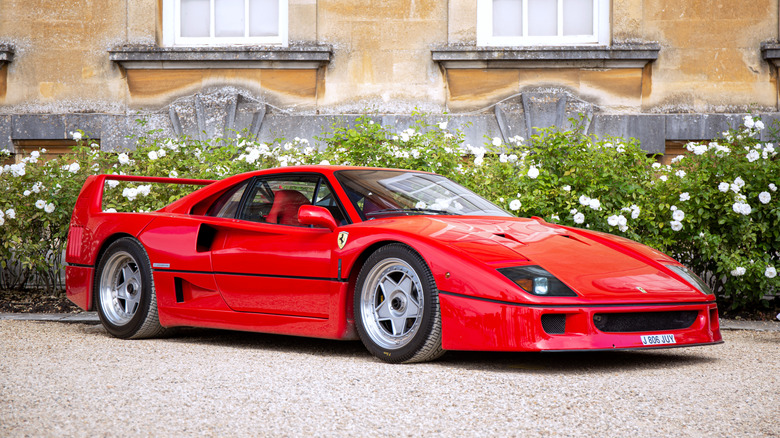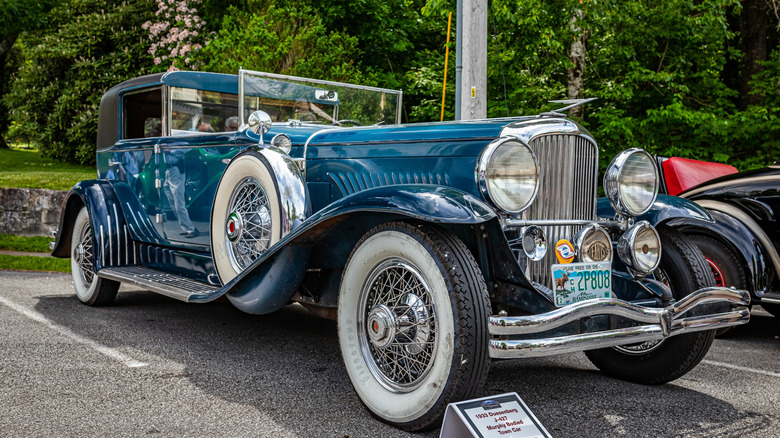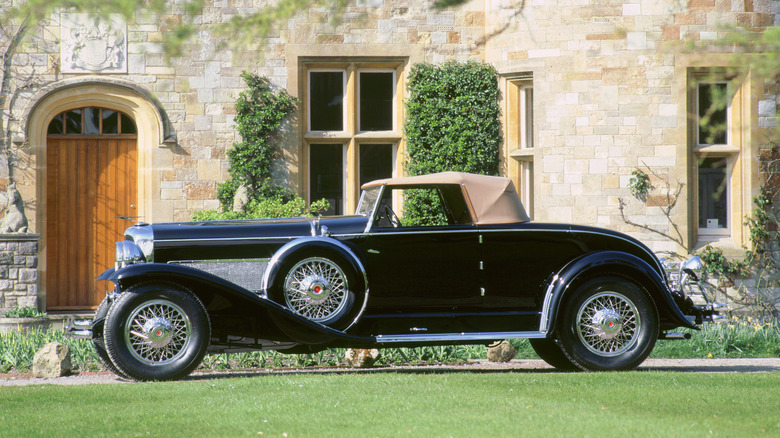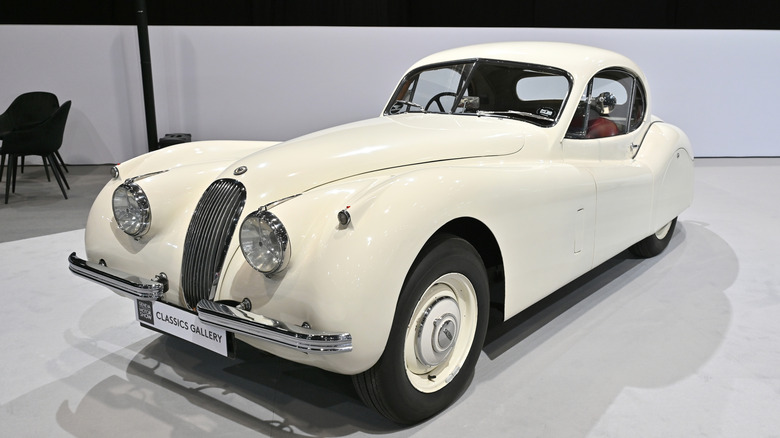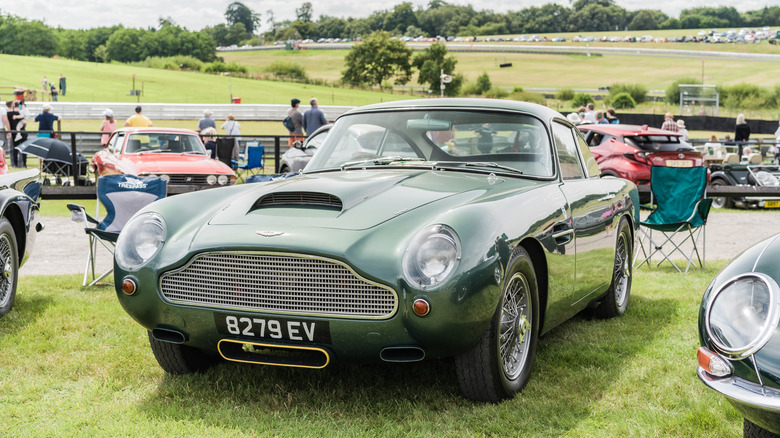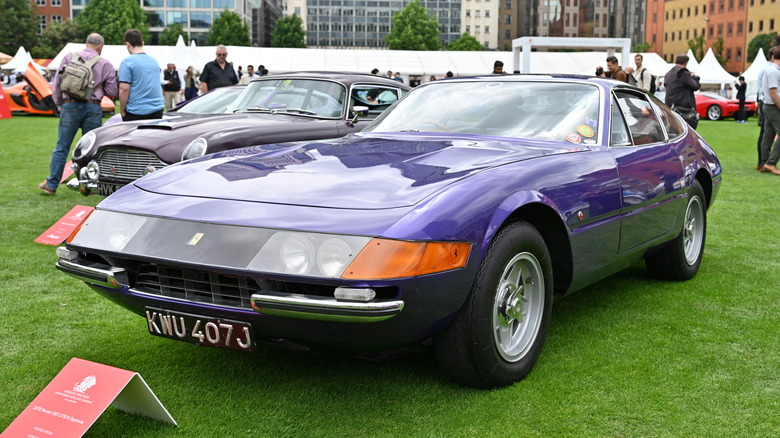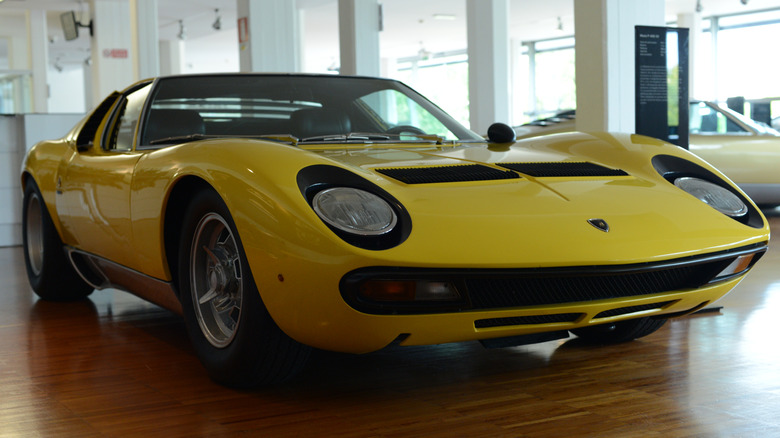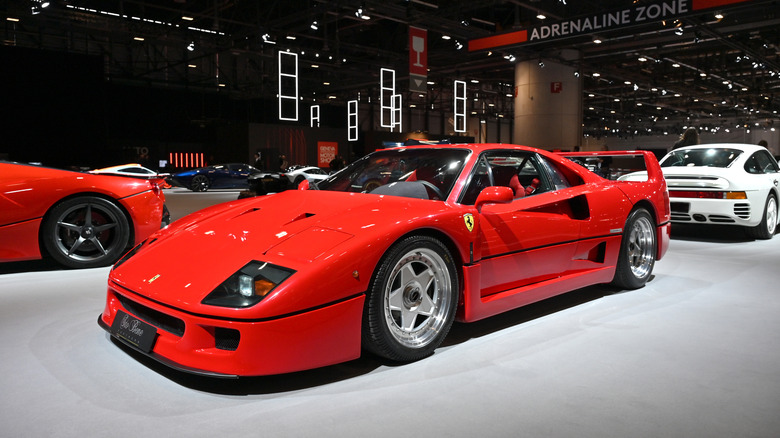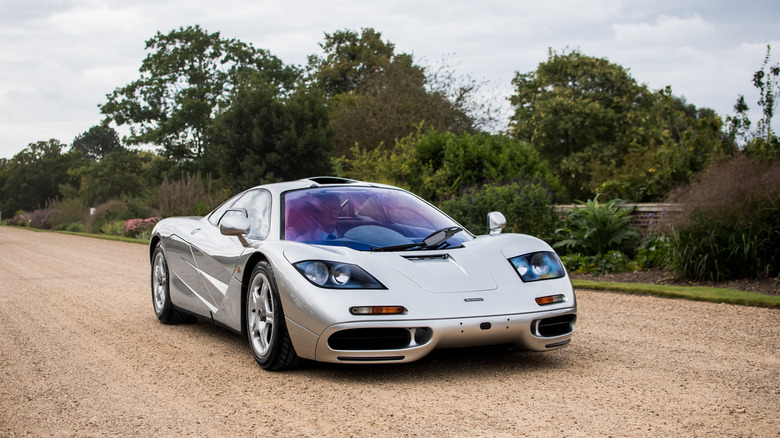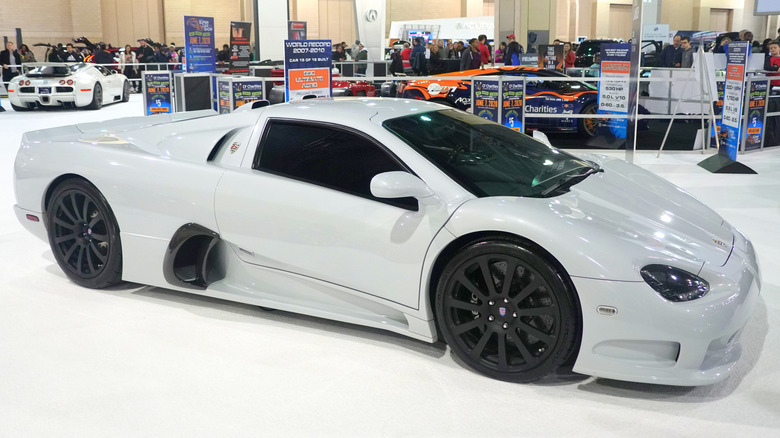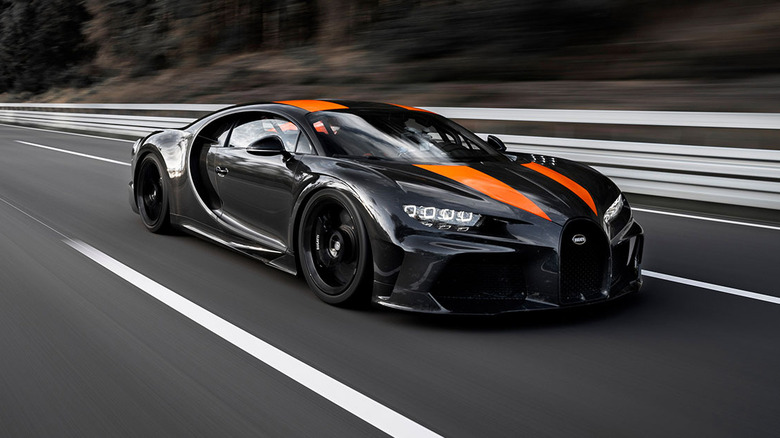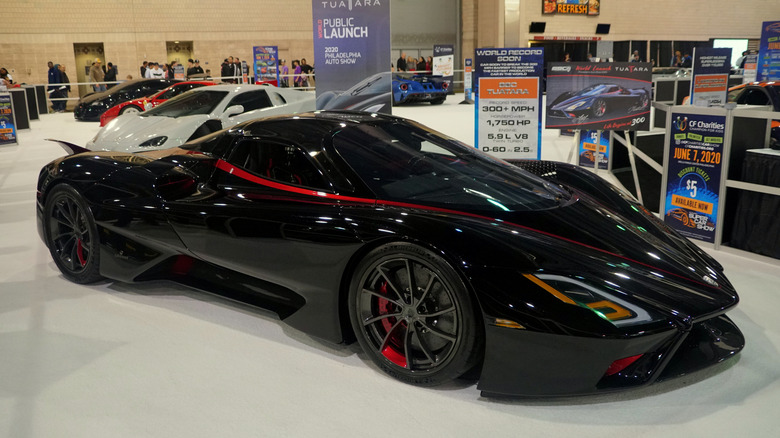These Are The Fastest Cars For Every Decade (Determined By Top Speed)
The automotive industry can trace its roots back to 1885, when Carl Benz developed the Benz Patent Motor Car. At this time, overall top speeds weren't much of a focus — all that mattered was a better traveling experience compared to the traditional horse and carriage. As the years went by, more manufacturers emerged, like Ford, which entered the automotive industry in 1896 with the quadricycle. But still, performance wasn't considered in the same way as it was in the following decades.
As brands started to be able to produce larger, more powerful engines, holding the title of building the world's fastest car became incredibly attractive. Offering luxury became the norm for brands such as Rolls-Royce with models like the Silver Ghost, while other manufacturers focused on building cars that provided more thrill, rather than just comfort. Over the decades, the competition to build the fastest car in the world has never dwindled, and it's alive more than ever in the 21st century. Starting from the 1920s, here are the fastest cars from each decade based on top speed.
1920s: Duesenberg Model J
The Roaring Twenties allowed multiple industries to expand at an unprecedented rate, and the automotive industry was no different. By this point, cars were no longer a new invention, and key manufacturers were constantly innovating models to give customers something they'd never seen before. Duesenberg was one of these manufacturers, which already had a solid standing within the luxury segment after the release of cars like the Model A in 1920. However, the bar was set by the Duesenberg Model J, which was released for the first time in 1928.
Like many luxury cars from this era, the Model J was big. With a wheelbase of 142.5 inches stretched over a timeless design, the Model J offered plenty of space for its passengers inside. However, it was the size and power of the engine that truly set it apart. The Model J was powered by a massive 6.9L inline-eight cylinder engine, producing 265 HP, which was seriously impressive almost 100 years ago. It was also fitted with a three-speed transmission and could climb to 90 MPH in second gear. Overall, the Model J could reach a top speed of 116 MPH, becoming the fastest production car of the 1920s and capturing the racing spirit that made Duesenberg so popular.
1930s: Duesenberg Model SJ
Duesenberg's domination didn't stop in the 1920s — instead, the American brand offered a more powerful version of the Model J. In 1932, the American automaker debuted the Duesenberg Model SJ, which took the base Model J and added a supercharger to its potent engine. The Model SJ subsequently came with the same inline-eight engine that featured in the Model J, but the centrifugal supercharger boosted the overall power output to 320 horsepower. For reference, this is approximately equal to what the first-ever Pontiac GTO produced in 1964, over 30 years after the Model SJ rolled out of the factory in Indianapolis.
With the increased power, the 1932 Duesenberg Model SJ could reach a top speed of up to 140 MPH, which kept it as the fastest car throughout the rest of the 1930s. Unfortunately, Duesenberg didn't manage to survive the Great Depression, leading to production of both the Model J and Model SJ ceasing in 1937. The Model SJ is said to have reached prices of $20,000 when it was released in 1932, which, when adjusted by inflation, equates to around $432,000 in 2025. In 2023, a bespoke 1935 Model SJ sold for a stunning $3 million.
1940s: Jaguar XK120
Ever since Jaguar was founded as the Swallow Sidecar Company in 1922, performance has remained a pillar of the iconic British brand. Towards the late 1940s, it wasn't uncommon for a brand's sports cars to enter various motorsport series to bolster its reputation, which was the case for the Jaguar XK120 that debuted in 1948. A year later, the two-door sports car entered the 24 Hours of Le Mans, also competing in various other high-profile races such as the Pebble Beach Road Race, in which legendary racer Phil Hill won the first ever event behind the wheel of the Jaguar.
The '48 Jaguar XK120 was the first model to use the brand's XK engine, which made it one of the fastest cars in the world at the time. The engine is a 3.4L six-cylinder, good enough to produce 160 HP. According to Jaguar, the XK120 has a top speed of 124.6 MPH, but during a test conducted by Motor Sport magazine in 1949, the sports car managed to reach 127 MPH flat out with the windshield fitted. Without it, the Jaguar went even faster, topping out at 133 MPH.
1950s: Aston Martin DB4 GT
Alongside Jaguar, Aston Martin is another iconic British brand that shaped the performance scene of the mid-20th Century. Founded some years earlier in 1913, Aston Martin already had plenty of incredible cars to its name before the 1950s, and the release of the DB4 grand tourer in 1958 only added to the list. The base model came with a 3.7L DOHC straight-six engine, producing a solid 240 horsepower and an equal amount of torque per pound-foot. However, the following year, the racing-focused DB4 GT was unveiled.
The 1959 Aston Martin DB4 GT came with multiple upgrades, with this version coming with a shorter platform and lower weight, alongside upgrades to the already potent engine. Three Weber carburetors were added to the 3.7L under the hood, which increased the overall power output to 302 horsepower, allowing for a top speed of 160 MPH. This quickly made the DB4 GT the fastest production car on the road — a production run that was limited to just 94 models overall. The renowned grand tourer ran from 1959 to 1963, being discontinued to make way for the DB5.
1960s: Ferrari 365 GTB/4
By the 1960s, Ferrari was already one of the most established automakers on the planet. Before it produced performance cars, the brand's name can be traced back to 1929 when Enzo Ferrari founded the racing team, Scuderia Ferrari, which produced many of Alfa Romeo's racecars in the 1930s. In 1947, the 125 S was released, which was the car that started Ferrari's line of production cars that continues today. The brand had many high points, but very few come close to the 1968 GTB/4, frequently called the Daytona, which became the fastest production car of its time.
Ferrari was already famous for its usage of V12 engines in its road cars, with the Ferrari GTB/4 featuring the very best of the bunch when it became available towards the end of the decade. The grand tourer was fitted with a 4.4L V12, complete with six Weber carburetors to achieve an overall power output of 352 HP. At its peak, Ferrari says that the GTB/4 can reach a top speed of 174 MPH, beating out every car from the Italian automaker that came before it on its way to becoming the fastest production car available.
1970s: Lamborghini Miura SV
The Lamborghini Miura was first released in the 1960s and was a close rival to the likes of the Ferrari GT4/B. While the original model's top speed was bested by the Ferrari, the improved SV model, released five years after the first Miura in 1971, put Lamborghini back on top of the industry when it came to outright speed. The original 1966 Miura is widely considered to be the first supercar due to its mid-engined 4L V12, which received more power as new editions of the car were released throughout its production run from 1966 to 1973.
The final iteration of the Miura, the P400SV, was unsurprisingly the most powerful and fastest of all production versions of the car. The SV was based on the extreme P400 Jota prototype that was created in 1970, carrying over its widened wheel arches and larger tires to accommodate the change in bodywork. The five-speed transmission was also improved, allowing the P400SV model to climb to its claimed top speed of 180 MPH much more smoothly. At the time, no other car could match the Miura, and no car throughout the 1970s managed to surpass its rating.
1980s: Ferrari F40
Shifting focus back to Lamborghini's main rival, the Ferrari F40 is without a doubt one of the most iconic models to ever be produced by the brand. Released in 1987, the F40 supercar acted as the 40th anniversary model for Ferrari. What puts this car in a league of its own is that it was the last-ever Ferrari approved by Enzo, who sadly died the year after the F40 made its debut. A major deviation from Ferraris that came before it in terms of styling, the F40 used lightweight materials to improve its performance, with a curb weight of 2425 pounds.
Instead of fitting the F40 with a V12, the Ferrari F40 was powered by a 2.9L turbocharged V8, derived from its predecessor, the 288 GTO. The result was the most powerful Ferrari car to date, with its power output reaching a staggering 471 HP and 426 LB-FT. Not only did this make the F40 the fastest car in the world upon its release, but it was also the first production car to break the 200 MPH barrier with a top speed of 201 MPH.
1990s: McLaren F1
The competition to produce the world's fastest car didn't slow down in the 1990s — if anything, the intensity only increased. Jaguar re-entered the picture in 1992, with aerodynamically-focused bodywork combined with a turbocharged V6 engine allowing for a top speed of 217 MPH. While this is good enough to rival some of the best supercars in the world in 2025, it wasn't able to hold on to the record for very long. In the same year, the McLaren F1 was released, which was the first production car from the legendary racing brand. An incredibly limited production of 106 units made the F1 even more special, and it still holds some of the records it set more than 30 years ago.
Powered by a mighty 6.1L V12 engine, the heart of the McLaren F1 was developed by BMW. The power output measured at 627 HP and 479 LB-FT, allowing it to shatter the production car speed record. After reaching 231 MPH during a 1993 test, the F1 became the world's fastest car, but in 1998, it achieved a top speed of 242 MPH at the hands of Andy Wallace, the winner of the 24 Hours of Le Mans endurance race in 1988. Taking the second run in the opposite direction into consideration, the McLaren F1's official top speed is 240.1 MPH, still significantly above the previous record.
2000s: SSC Ultimate Aero TT
When SSC revealed the Ultimate Aero in 2004, the brand didn't have the same legacy and recognition as many of the other brands featured on this list. While the standard Ultimate Aero model wasn't the fastest car in the world soon after it released — that record belonged to the legendary Bugatti Veyron, which set a top speed of 253.81 MPH in April 2005, dethroning the Koensigegg CCR in the process that managed to reach 241 MPH in February of the same year. However, in 2007, SSC introduced the Ultimate Aero TT, the twin-turbocharged variant of the base 2004 supercar.
The addition of these turbochargers increased the power output of its 6.3L V8 engine to 1,183 HP and 1,094 LB-FT. In a test verified by the Guinness Book of World Records, the SSC Ultimate Aero TT reached a top speed of 256.2 MPH, becoming the world's fastest car by another small margin. The Ultimate Aero TT's record lasted longer than the Koenigsegg CCR's, but was eventually bested by the Bugatti Veyron Super Sport in 2010, which reached 268 MPH.
2010s: Bugatti Chiron Super Sport 300+
The record set by the Bugatti Veyron Super Sport stood for quite some time, becoming a key reason as to why the hypercar is still so revered. It held the title for the world's fastest car for seven years, up until Koenigsegg returned to reclaim the record from Bugatti with the Agera RS in 2017. Achieving an incredible top speed of 277.87 MPH, the Agera RS beat the Veyron Super Sport by a healthy margin, considering how close the records were in the decade prior. However, two years later, Bugatti once again toppled Koenigsegg with the Chiron Super Sport 300+.
The Chiron replaced the Veyron for the 2017 model year, which received its own Super Sport variant in the following year. In 2019, Bugatti made history with a special version of the Chiron Super Sport, aptly named the 300+, by becoming the first car to breach the 300 MPH barrier. The Chiron Super Sport 300+ achieved an official top speed of 304.78 MPH, thanks to its 8.0L W16 engine and long-tail design. It must be noted that due to the Chiron Super Sport 300+ not being fully homologated, the Agera RS is still the world's fastest fully homologated car, even if it doesn't have the overall record anymore. Customer versions of the Super Sport 300+ that were made available from 2021 were also limited to 275 MPH.
2020s (So Far): SSC Tuatara
While we're only halfway through the 2020s, we've still seen manufacturers attempt — and get very close — to breaking the record set by the Chiron Super Sport 300+. Outside of the top speed record, the Koenigsegg Jesko Absolut has been setting the standard elsewhere, earning a new world record by going from 0-250-0 MPH in 28.27 seconds, reaching a top speed of 256 MPH on the same day. While Koenigsegg hasn't pushed the Jesko Absolut's limit, which the brand believes can exceed 300 MPH with relative ease, SSC has since made a return to produce yet another one of the world's fastest cars.
The SSC Tuatura, the latest model from the high-performance automaker, recently hit a top speed of 295 MPH in May 2022. Like the Chiron Super Sport 300+, however, the car that achieved this feat wasn't homologated for road use, which keeps that accolade within Koenigsegg's grasp. Before the SSC Tuatara's official run, the brand claimed that it hit 331 MPH, but later confirmed that to be false. Still, no other car has managed to top the Tuatara's official 295 MPH figure, placing the American hypercar as the fastest car of the 2020s so far.
